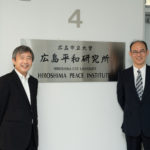About this Publication
This book is a compilation, presented in a report format, of the results of the “Hiroshima Reconstruction and Peacebuilding Research Project,” a two-year project spanning from 2012 to 2013. The project was undertaken by the “‘Hiroshima for Global Peace’ Plan Joint Project Executive Committee,” organized by Hiroshima Prefecture and the City of Hiroshima.
On August 6, 1945, at 8:15 in the morning, Hiroshima was destroyed by a single atomic bomb. Many precious lives were taken by the bomb, and the city was completely annihilated. The bomb also literally wiped out the region’s entire history, culture, and memories of families, which had been established over the years, along with the lives of the people living there.
For sixty-nine years after the explosion, the survivors of the bombing and other residents of Hiroshima have continued to call for a world free from nuclear weapons. We have done so with a conviction, based on our experiences, that such a disaster by nuclear weapons must never be repeated. We must never give up in our efforts to realize the abolition of nuclear weapons as soon as possible.
Even though it was once said, “Grass and trees won’t grow for seventy-five years” in Hiroshima, the city has been reconstructed as a “City of Peace” thanks to the efforts of our predecessors. What Hiroshima is today fascinates many tourists visiting the city. Many people who walk through the city after visiting the Hiroshima Peace Memorial Museum are moved and surprised at the sight of locals living among the green and flower-filled streets.
As a city that has been successfully reconstructed from ruins, Hiroshima would like to contribute to the realization of a peaceful international community by utilizing its knowledge of reconstruction and peacebuilding to support post-conflict countries in the world.
Focusing on Hiroshima’s process of overcoming various difficulties and its successful recovery, this research examines how modern Hiroshima has forged its identity as a city that succeeded in reconstruction and that seeks peace. The study also includes and relates both the mentality of Hiroshima’s citizens, who themselves rose up from the ashes, and external factors that supported the city’s reconstruction, including various kinds of assistance extended to Hiroshima from within Japan and abroad.
We hope this report will help readers reflect on the history of Hiroshima’s reconstruction and understand the enormous losses caused by the atomic bombing and the new values born afterward. We also hope that this report will support reconstruction efforts and peacebuilding in post-conflict countries and contribute to the realization of a peaceful and stable international community.
Finally, we would like to express our deepest gratitude first to Professor Kazumi Mizumoto, Vice President of the Hiroshima Peace Institute of Hiroshima City University, who has worked painstakingly as the chair of the editorial committee for this research project, and to all members of the editorial committee, those who have contributed articles and columns in their fields of expertise, and all others who have offered invaluable advice and resources.
March 2014
Hidehiko Yuzaki, Governor of Hiroshima Prefecture
Kazumi Matsui, Mayor of the City of Hiroshima






